Phone:
(701)814-6992
Physical address:
6296 Donnelly Plaza
Ratkeville, Bahamas.
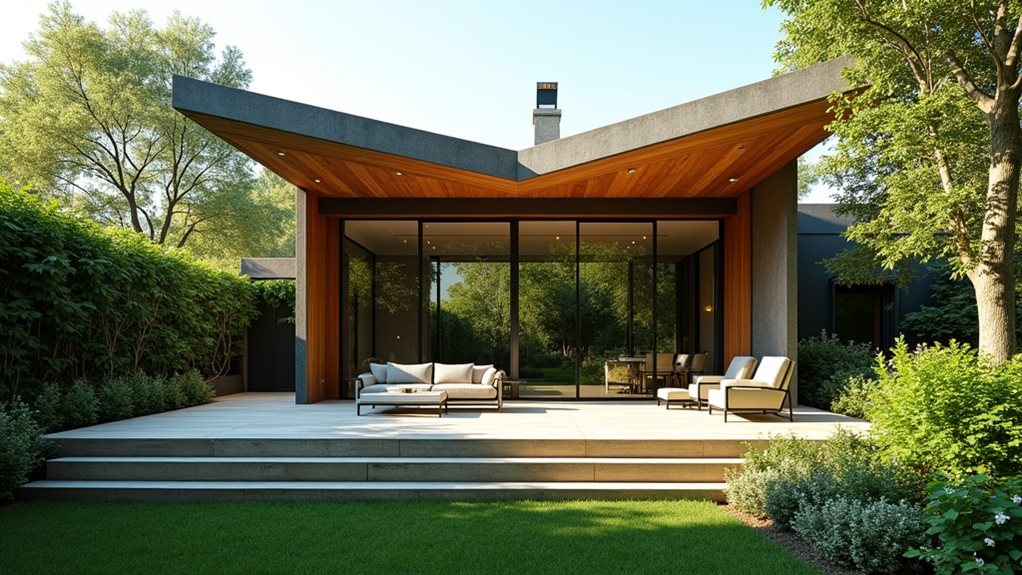
Kickstart your home transformation with 10 unique extension ideas that will captivate your senses and inspire your next design project. Discover what awaits!
Looking to expand your home? Consider incorporating modern architecture with frameless glass roofs for natural light and sleek design. Open-plan living optimizes space, while integrating sustainable materials, like reclaimed wood, enhances both aesthetics and eco-friendliness. Don't forget about outdoor extensions; blending your indoor and outdoor spaces can create a seamless feel. Vertical space is key, so think about adding lofts or double-storey designs. For luxury, custom millwork and sophisticated lighting can elevate your home. By understanding local regulations and planning carefully, you'll set yourself up for success. There's so much more to explore, and you'll want to keep going.
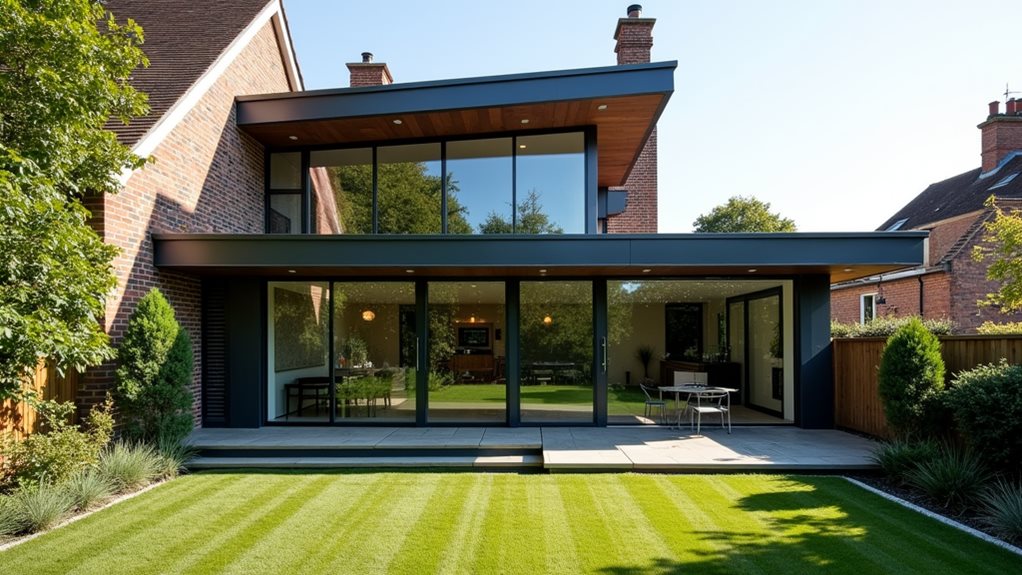
When you're looking to extend your home, incorporating modern architecture can truly elevate your space. By embracing modern aesthetics, you can create an environment that feels fresh yet welcoming.
Think about using frameless glass roofs that give a sleek finish, allowing natural light to pour in and link your indoor spaces to the outdoors. Materials like eco-friendly Siberian larch and Cor-ten steel not only contribute to architectural harmony but also send a message of sustainability and sophistication. Working with local house extension builders can ensure that your vision is realized effectively.
Imagine walking into a space defined by dynamic cantilevered extensions, enchanting everyone who enters. You might consider flat roof rear extensions that enhance large kitchen diners, perfect for gatherings and shared moments. Including proper planning is essential to manage costs effectively without sacrificing quality.
Adding skylights or bifolding doors invites the outdoors in, creating seamless connections that foster connection and comfort.
Keeping a consistent material palette is essential, as it ties both modern and traditional elements together beautifully. The innovative use of timber diagrids can offer striking canopies, generating warmth and elegance.
Ultimately, this balance allows you to truly express your style, making your home an inviting haven that embraces both the future and your cherished past.
Incorporating modern architecture sets the stage for a seamless integration of open-plan living spaces, where functionality and style come together. This design choice not only enhances your home's aesthetics but also fosters a sense of community among occupants. To make the most of your open-plan layout, think about zone creation and space optimization that blends comfort with practicality. Here are some ideas to help you define your space:
When designed thoughtfully, open-plan spaces offer versatility—allowing for everything from family gatherings to quiet retreats. Utilize natural light with expansive windows or skylights, and consider minimal divisions, like glass partitions, to keep the airy feel.
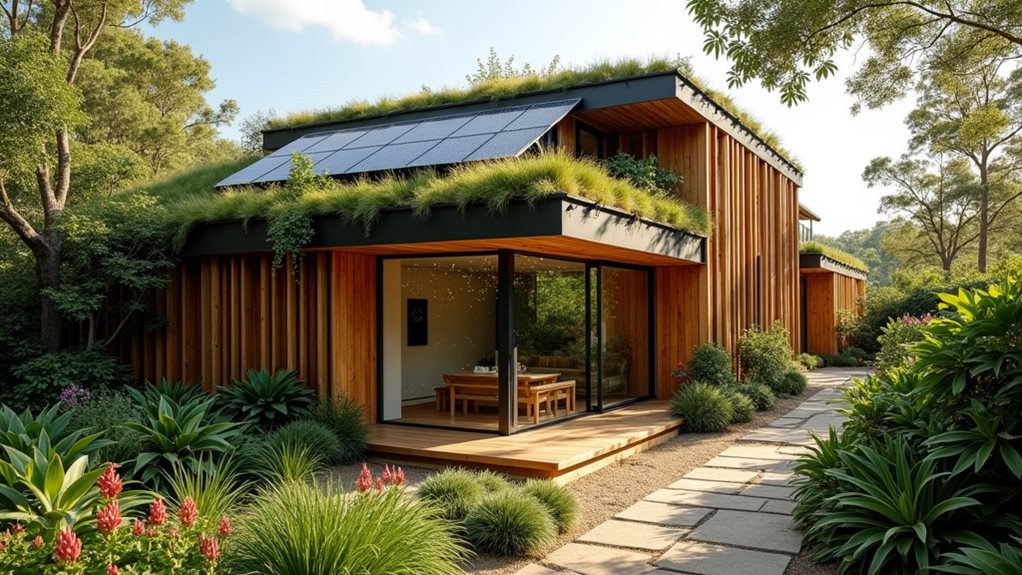
When you're planning your home extension, utilizing sustainable materials can really elevate the project while being kind to the planet.
From reclaimed wood to hempcrete, these eco-friendly resources not only enhance your space's character but also contribute to energy efficiency and reduced carbon footprints.
Let's explore the benefits of these materials and how to seamlessly implement them into your design.
Utilizing sustainable materials in your home extension not only benefits the environment but also enhances your living space in various ways. By incorporating recycled materials and embracing sustainable design, you create a home that's both beautiful and eco-friendly.
Here are a few benefits you might appreciate:
You'll find that sustainable materials don't just contribute to a healthier planet; they can also save you money with their long-lasting nature, resulting in decreased maintenance and energy bills.
In addition, sourcing materials locally can strengthen community ties and support local businesses. Overall, choosing sustainable materials for your home extension aligns your living space with your values, creating an inviting atmosphere you can be proud of for years to come.
Choosing the right materials for your home extension plays a crucial role in achieving sustainability. You'll want to explore eco-friendly innovations that not only benefit the planet but also enhance the comfort and beauty of your space.
Start by considering reclaimed wood, which reduces the demand for new lumber, or bamboo, an incredibly fast-growing resource perfect for flooring. Recycled metal can give your extension a unique flair while conserving raw materials.
Don't overlook the magic of natural fibers like hemp—they're excellent for insulation and really breathe well. Plus, using low VOC paints can greatly improve your indoor air quality.
Think about sustainable sourcing too; sourcing materials locally minimizes transportation emissions and supports your community.
Investing in modular designs can cut down on waste and streamline construction, whereas passive design strategies let natural light and airflow do the heavy lifting.
Both choices help reduce your overall environmental impact. By consciously selecting eco-friendly materials, you're not just making a responsible choice for your extension—you're actively contributing to a healthier home and planet, creating a space where you and your loved ones can truly thrive.
As you plan your home extension, integrating sustainable materials is essential to reducing your environmental footprint. Choosing the right materials not only enhances the beauty of your space but also promotes eco-friendly practices.
Consider these options to make your extension truly green:
You can also enhance your extension with sustainable landscaping and eco-friendly furnishings to create a holistic living space.
Look into green roofing for insulation and consider energy-efficient installations like solar panels to power your new area.
By weaving sustainable materials and practices into your home extension, you'll not only create a comfortable and inviting space but also foster a deeper connection with the environment.
Embrace these ideas, and you'll be proud of your commitment to sustainability.
To create a seamless connection between your home and outdoor spaces, consider how design elements can enhance the integration of both environments.
Start with glass extensions; they'll flood your interiors with natural light and offer breathtaking views of your garden. Using matching materials and colors for both indoors and outdoors fosters a cohesive aesthetic that welcomes you each time you step outside.
Incorporating plants inside can echo the garden's beauty, making your home feel like a natural extension of your outdoor surroundings.
To truly enjoy these spaces, design patios or decking that extend your living areas, providing ample space for entertaining friends or enjoying quiet evenings.
Adding tranquil water features, such as ponds or fountains, brings a soothing element to your outdoor environment, further enriching your gathering spaces.
You should develop a base plan that details how you'll utilize these areas, ensuring seamless connections between each space.
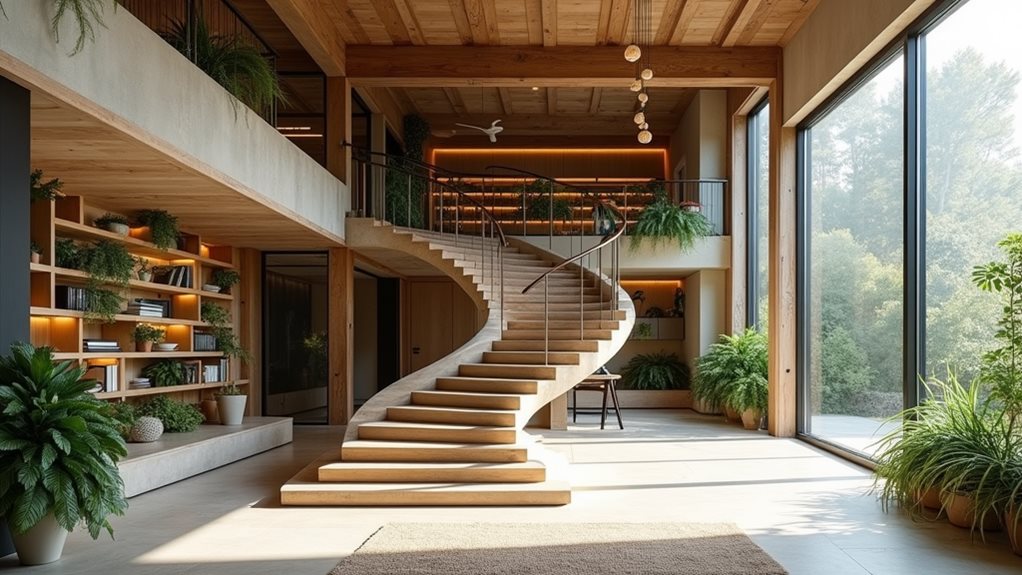
Maximizing vertical space can truly transform your home into a more functional and inviting environment. Embracing the heights in your rooms not only creates an open feel but also allows you to utilize every inch effectively.
Consider clever options like vertical gardens, which can add a splash of greenery while making use of wall space.
Here are some ideas to inspire your vertical transformation:
Incorporating high ceilings, mezzanine levels, or even elevated areas can redefine your living areas.
With these creative touches, you'll not only improve the functionality of your rooms but also foster a sense of belonging and warmth.
Transforming your home isn't just about utilizing space effectively; it's also about making it a reflection of your personality and lifestyle. Personalizing your design is where your personal style truly shines.
Consider custom-built archways or dramatic ceiling designs, adding that unique touch that sets your home apart. Materials like reclaimed wood or exposed brick not only introduce character but also tell a story—your story.
Creating multi-functional spaces can enhance your everyday life. Picture a home office that doubles as a cozy guest room or a playroom that's also a workout haven. This design customization makes your home versatile, adapting as your needs change.
You should also think about tailoring spaces to your lifestyle. A reading nook nestled in natural light can become your new favorite retreat, while a thoughtfully placed wine cellar showcases your interests.
Adding smart home technology can heighten comfort, making your space truly yours.
Lastly, enhance aesthetic appeal by coordinating the extension's design with your existing home. Incorporate high-quality finishes, natural materials, and cozy lighting to create an inviting atmosphere that's unmistakably you.
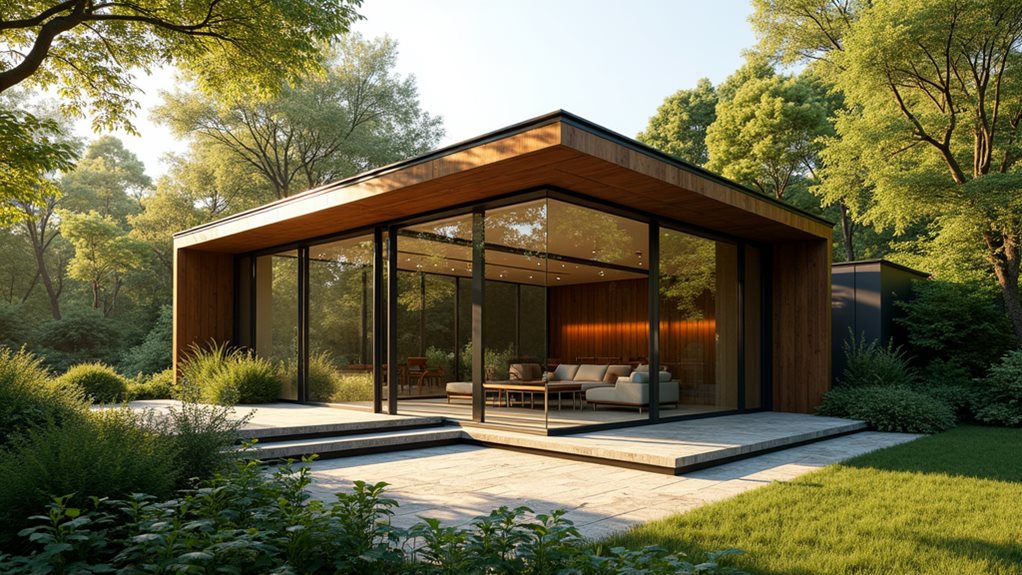
When you're planning a home extension, understanding local regulations is essential to guarantee your project runs smoothly.
You'll need to get acquainted with zoning laws, the permitting process, and building codes, as these will directly affect what you can build and how.
Understanding zoning laws is essential for homeowners looking to extend their property without running into legal hiccups. These regulations can vary markedly from one area to another, so familiarity is key.
You'll want to tackle these zoning challenges head-on with effective compliance strategies.
It's important to conduct an extensive review of zoning laws before starting your home extension journey.
Be sure to adhere to local density requirements and make structural assessments, such as soil testing, especially if you're considering vertical enlargements. Engaging professionals can smooth out the process, ensuring you won't face delays or costly redesigns due to non-compliance.
Remember, understanding your local zoning regulations is a critical step toward creating a space that not only meets your needs but also respects the community you're part of.
Take these steps to avoid complications, and you'll set yourself up for success!
Steering through the permitting process can feel overwhelming, but breaking it down into manageable steps makes it more approachable.
To kick things off, you'll need to prepare a thorough permit application that includes detailed plans, architectural drawings, and site plans. These should clearly outline your proposed addition and provide necessary specifications and materials. Don't forget to include proof of property ownership, like a deed or title, as it's vital for the approval.
Engaging with your local building department is essential. Start with consultations and plan reviews to guarantee your project aligns with zoning ordinances and complies with local regulations.
They'll evaluate your plans for structural integrity, fire safety, accessibility, and energy efficiency—so thorough preparation is key.
As you submit your application, remember that the plan review period might take several days. Once construction begins, post-inspections are required to maintain ongoing compliance.
And keep track of your permit's timeline, as it can expire if work isn't completed within the specified timeframe. By staying organized and proactive, you'll navigate the permitting process efficiently, paving the way for your unique home extension.
Building codes are vital guidelines that govern how your home extension should be designed and constructed. Following these codes guarantees you achieve building code compliance, which protects not just your investment but also the safety of everyone who occupies the space.
Here are some key elements to take into account:
Understanding your local building codes is significant, as they cover everything from the size and placement of rooms to environmental factors.
Each local jurisdiction has different regulations, so working closely with your contractor and building officials can help you navigate this complex landscape.
Remember, compliance isn't just about following rules; it's about creating a home that's safe, comfortable, and valuable.
When you prioritize these standards in your extension project, you contribute to a stronger community while enjoying your enhanced living space.
Exploring innovative extension features can transform your home into a more functional and enjoyable space. By embracing cutting-edge design trends, you can maximize both style and extension functionality.
For instance, consider a rear extension that opens up your living area to the garden, enhancing natural light and creating a seamless indoor-outdoor flow. Large windows or glass doors not only invite sunlight but also provide lovely views, turning your home into a peaceful retreat.
If you're short on ground space, a second-storey extension could be your best bet. It allows you to add bedrooms or a home office without encroaching on your yard. Imagine having a peaceful parent's retreat or a vibrant playroom above while maintaining your outdoor haven.
Additionally, incorporating unique structural elements like cantilever balconies or vaulted ceilings can dramatically enhance both visual appeal and functionality. These features create a more dynamic living environment, encouraging you to relax and enjoy your space.
Ultimately, the goal is to blend these innovative features with your home's existing character, ensuring it reflects your personal style while meeting your family's needs. Embrace these ideas, and you'll cultivate a space that truly feels like home!
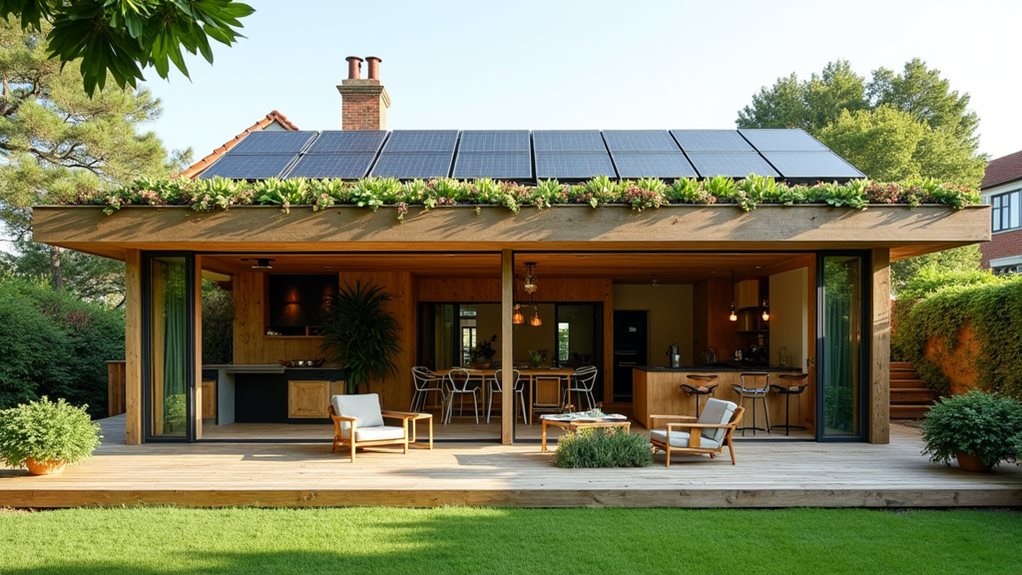
Incorporating eco-friendly home solutions into your extension design not only benefits the environment but also enhances your living space's comfort and efficiency. By embracing green building principles, you can create an inviting home that supports energy efficiency, ultimately reducing your long-term expenses.
Here are some key strategies to evaluate:
As you plan your eco-friendly extension, prioritize a fabric-first approach, optimizing insulation and natural ventilation to lessen your reliance on mechanical systems.
Remember, the more airtight and efficiently designed your space, the more energy you'll save.
By focusing on these sustainable practices, you create a welcoming environment for family and friends while doing your part for the planet.
Embracing eco-friendly solutions fosters a sense of belonging and connection to both your home and your community.
When you're considering a home extension, luxury options can transform your living space into a stunning retreat that reflects your personal style and enhances your comfort.
Imagine basking in a serene environment adorned with exquisite custom millwork options, like coffered ceilings and intricate cabinetry that showcase your identity. You want your home to feel cohesive, right? Focusing on high-end lighting can elevate the ambiance, with elegant chandeliers and wall sconces casting a warm glow throughout your new space.
Think about adding space with a double-storey extension to accommodate those extra bedrooms or a basement development that serves as a cozy media room. Each choice plays an essential role in creating the perfect atmosphere for family gatherings or intimate evenings.
Consider integrating sustainable materials as well—luxury doesn't have to compromise eco-friendliness.
Architectural features like glass walls offer breathtaking views and enhance natural light, while elegant exotic hardwoods lend a touch of sophistication.
Every detail contributes to a unique space where memories are made and cherished. So, embrace the luxury—your dream home extension awaits!
Designing your home extension can feel like piecing together a puzzle—every choice shapes your living space. Just as an artist blends colors on a canvas, you have the opportunity to combine functionality with style. By embracing modern design elements, sustainable materials, and innovative features, you'll not only enhance your home's beauty but also its value. Remember, it's about creating an environment that reflects your lifestyle, so take the time to craft a space that feels uniquely yours.